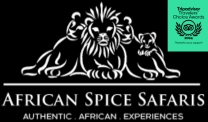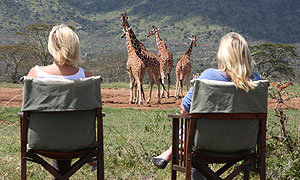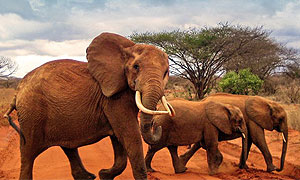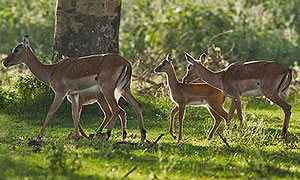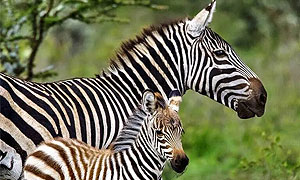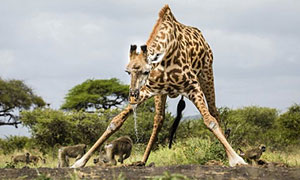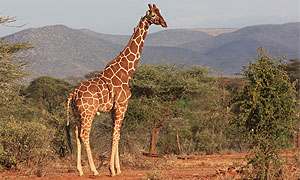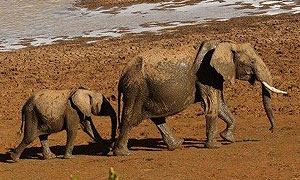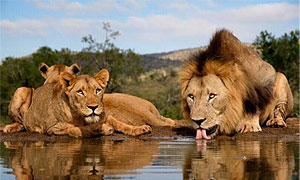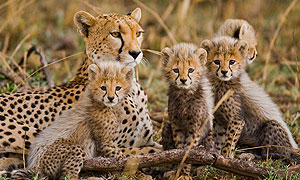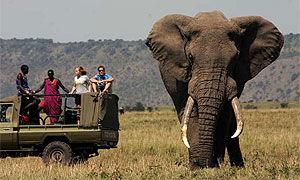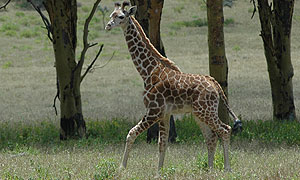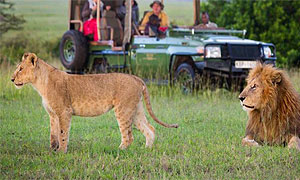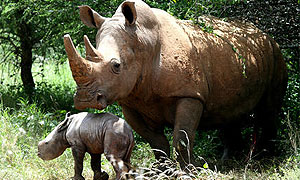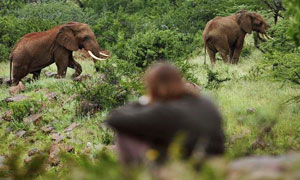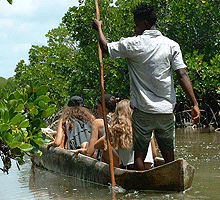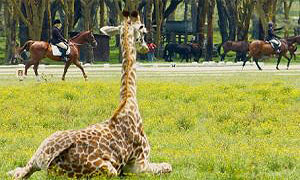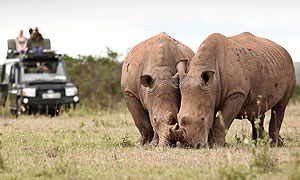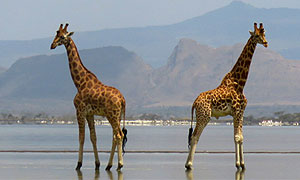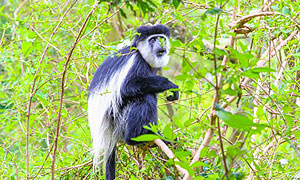Kenya Wildlife Conservancies & Wildlife Sanctuaries
Kenya Wildlife Conservancies are land managed by an individual landowner, a body or corporate, a group of owners, or a community for wildlife conservation and other compatible land uses to better livelihoods. Kenya has 4 types of conservancies which include Community conservancies, Group Conservancies, Private Conservancies, and Co-Managed Conservancies.
Community Conservancies are conservancies established by a community on community land. These include Melako Conservancy, Malkahalaku Conservancy, Lokichar, and Oldonyo Waus Conservancy located within Imbirikani in Amboseli.
Group conservancies are conservancies created by the pooling of land by private landowners who share a common border for wildlife conservation. These include Mara North Conservancy, Pardamat Conservation Area, and the Mara Nabosho Conservancy.
Private Conservancies are conservancies set up on private land by a private individual or corporate body for wildlife conservation. These include Laikipia Nature Conservancy, Ol Pejeta Wildlife Conservancy, Rukinga, and Lentolia Farm private conservancy.
Co-managed conservancies are arrangements between a government agency/authority and a community or private person/persons to conserve specific public land.

Kenyan Wildlife Conservancies: there are 160 conservancies presently.
Kenya Wildlife Conservancies

Borana Conservancy
Borana Conservancy, situated at the base of Mt. Kenya on the Laikipia Plateau, spans 32,000 acres and serves as a sanctuary for endangered species, including Black and White Rhinos. Visitors can reach Borana by road, taking a scenic drive from Nairobi, or by air with commercial flights from Wilson Airport in Nairobi. The area is home to over 20 species of mammals, with around 3,000 elephants monitored through radio collars to reduce human-wildlife conflict. Bird enthusiasts can explore the diverse avian life, with nearly 400 species documented. Visitors to Borana Conservancy can engage in various activities, such as fly-camping, rhino tracking, guided bush walks, and helicopter safaris. Cultural experiences include visits to the local Maasai community and nearby schools supported by the Conservancy. Adventure options like mountain biking, horse riding, and game drives provide immersive wildlife encounters, while visits to the Reteti Elephant Orphanage and Ngare Ndare Forest offer unique conservation insights. Accommodation within the Conservancy includes exclusive options like Arijiju Retreat, Borana Lodge, Lengishu House, Laragai House, and Sirai House, each offering luxurious stays with stunning views and easy access to the Conservancy’s attractions. To visit Borana, guests must book accommodation at one of these properties, ensuring an intimate and personalized experience in this pristine wilderness.
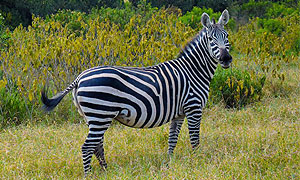
Crater Lake Game Sanctuary, Naivasha - Kenya
Crater Lake Game Sanctuary Naivasha is located 6 miles (10 km) from Naivasha town and about 56 miles (90 km) from Nairobi. This is a small private sanctuary centered around a small, saline-alkaline lake called Crater Lake (also called Sonachi) to the immediate west of Lake Naivasha and north of the village of Kongoni. The alkaline lake changes from blue to emerald green and back again with each passing hour, and is the nesting place for a myriad of birds – majestic fish eagles, busy weavers, cheeky robin chats, as well as ibis, kite, ducks, sunbirds, fire finches, and the tiny and colorful cordon bleu. Animals include giraffes, eland, bushbuck, jackal, baboons, colobus and vervet monkeys, hyenas, warthog, hippos, dik-dik, kongoni, duiker, serval, aardvark, badgers or even leopard. Crater Lake Game Sanctuary accommodations include Crater Lake Lodge. Things to do at Crater Lake Game Sanctuary include Escorted game walks, Boating on the lake, Horse riding, Day & Night drives, Bird walks, Stargazing, Crater rim sundowners, Candlelit “lake dinners”, Historical tours, or do absolutely nothing.
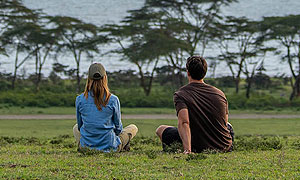
Crescent Island Game Sanctuary
Crescent Island Game Sanctuary is located in Lake Naivasha about 93 km (58 miles) northeast of Nairobi. The park is located in the middle of the lake with miles of walking trails and abundant wildlife that provides a 360-degree view of Mt. Longonot to Hell’s Gate to the Mau Escarpment to Eburu and onto the Aberdares, the view simply blows your mind away. Surrounded by Lake Naivasha a fresh air breeze throughout your adventure here is guaranteed. Among activities, visitors can do here includes; taking a walk among wild animals without fear of harm or danger. These include herbivores such as Defassa Waterbuck, Cape Buffalo, Wildebeest, Masai Giraffe, Burchells Zebra, Impala, Hippopotamus, Thompsons Gazelle, Grants Gazelle, Bat Eared Fox, Kirks Dik Dik, Vervet Monkey, Bushbuck, Silver Backed Jackal, African Rock Python and many birds such as goliath heron, spoonbills, and giant kingfishers. These animals were brought here to film Out of Africa and were left here to thrive. There are no predators on the island. Other activities include boat rides, photography, yoga/meditation, bird watching, team building, and, fishing and picnicking. The Crescent Island opens at 8.00a.m and closes at 6.00 p.m daily and their respective charges are applicable to each individual.

David & Daphne Sheldrick Elephant Orphanage (Sheldrick Wildlife Trust)
The Daphne Sheldrick Elephant Orphanage, part of the Sheldrick Wildlife Trust (SWT), is a sanctuary located within Nairobi National Park. Founded in 1977 by Daphne Sheldrick in memory of her late husband, David Sheldrick, it rescues, rehabilitates, and reintroduces orphaned elephants into the wild, focusing on those whose mothers were lost due to poaching or human-wildlife conflict. The orphaned elephants are cared for at the Nairobi Nursery before being relocated to reintegration units in Tsavo National Park. The orphanage also rescues other wildlife species, such as rhinos and giraffes. The public can visit the orphanage daily from 11 AM to 12 noon to witness the elephants’ midday feeding and mud bath. During this visit, keepers share stories about the elephants and conservation efforts. Visitors can touch the elephants but are not permitted to feed them. Booking in advance is required, and the Kenya Wildlife Service (KWS) park fee must be paid. Private visits can also be arranged between 3 PM and 4 PM for a more intimate experience, allowing adopters to spend time with the elephants. For $50 per year, individuals can adopt an elephant, receiving an adoption certificate and updates on the animal’s progress.

Giraffe Center Nairobi (African Fund for Endangerd Wildlife)
Giraffe Centre Nairobi is a non-profit nature education center located in Langata, approximately 40 minutes from the city center. Established in 1979 by Jock and Betty Leslie-Melville, the center was created to protect the endangered Rothschild giraffe. It operates as a breeding center and an educational hub, teaching thousands of Kenyan schoolchildren about wildlife conservation. Visitors to the Giraffe Centre can enjoy feeding giraffes from a raised platform, taking guided nature walks, and learning about conservation efforts. Bird watching is another popular activity, with numerous species around the center. The Giraffe Centre is about 15 kilometers from Nairobi's city center and accessible via Langata Road. The best time to visit is during the dry season from December to March and June to October, but it remains open year-round. Accommodations near the center include Giraffe Manor, a luxurious boutique hotel where giraffes roam freely, offering a unique dining experience. Other options include The Retreat at Giraffe Manor, Olsupat Lodge, House of Waine, Acacia Tree Lodge, and Hemingways Nairobi which have easy access to Nairobi's wildlife attractions. In addition to the Giraffe Centre, visitors can explore nearby attractions through guided tours, including visits to the Karen Blixen Museum and the David Sheldrick Elephant Orphanage.

Kipini Wildlife Conservancy
Kipini Wildlife Conservancyy is located on the coast in the eastern part of Kenya. It resides in Lamu and Tana River districts but is connected ecologically with Ijara District.

Kilimandege Sanctuary Naivasha
Kilimandege Sanctuary is located on Moi South Lake Road in Naivasha between Longonot Farm and Simba Lodge. The private sanctuary covers an area of 88 acres and boasts over 350 species of birds and animals such as giraffes, zebra, waterbuck, and gazelle. The Kilimandege Sanctuary is proud to also be home to the Kenya Bird of Prey Trust. Kenya has over 70 diurnal birds of prey (raptors) in addition to 19 nocturnal birds of prey (owls). These include the smallest Pygmy Falcon to the mighty Crowned Eagle and Verreaux’s Eagle. Today the Trust has in its care roughly 40 birds. Six species of vultures are classed as critically endangered. Threats to birds of prey in Kenya range from electrocution by powerline poles, habitat destruction and fragmentation, and persecution and poisoning. When you visit Naivasha Raptor Centre you will have a unique opportunity to learn about the amazing birds of prey across East Africa, their habitats, the threats they face, and what can be done about it. You are guaranteed to form a whole new attitude toward vultures by the time you leave. The Naivasha Raptor Centre is open to visitors daily at 1100 hours and 1500 hours (by appointment only). Activities in the sanctuary include guided game walks, sun-downers, massages, manicures and pedicures, relaxation at Otters guesthouse or Kilimandege guest house.
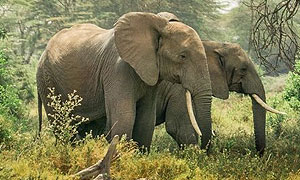
Kimana Sanctuary - Amboseli Ecosystem
Kimana Sanctuary can be accessed both by road and by air. By road, it is approximately 230 kilometers from Nairobi, with a journey time of around 3.5 hours on a paved highway that leads directly to the sanctuary gate. From Amboseli National Park, the drive is short and convenient, taking less than 30 minutes. Travelers from Mombasa can reach the sanctuary in about 5–6 hours via the Mombasa-Nairobi highway, connecting through Emali and Loitokitok. By air, visitors can fly into the Kimana Airfield located within the sanctuary, which is serviced by scheduled flights from Nairobi and other safari circuits, as well as private charters. Alternatively, flights to Amboseli Airstrip are available, followed by a road transfer of approximately 45 minutes to the sanctuary. The sanctuary is most famous for its free-roaming elephant population, including several of Africa’s last remaining “super tuskers.” Lions, leopards, buffalo, giraffes, zebras, and a wide variety of plains game are also present, supported by healthy wetland habitats. Over 400 bird species thrive here, making it a rewarding destination for both wildlife viewing and birdwatching. Kimana Sanctuary is unique in its exclusivity. Angama Amboseli Lodge is the only property located within the conservancy, and only its guests enjoy unrestricted access to game drives, night drives, walking safaris, and other activities inside the sanctuary. This ensures a private and low-impact safari experience while directly supporting local communities and conservation efforts.
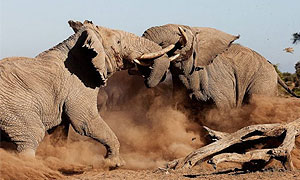
Kitirua Conservancy - Amboseli Ecosystem
Kitirua Conservancy is the oldest and largest conservancy in the Amboseli ecosystem, established in 1984 to protect a vital 30,000-acre wildlife corridor on the southwestern edge of Amboseli National Park. Stretching across open plains and seasonal riverbeds, Kitirua forms a critical transboundary link with Tanzania’s Enduimet Wildlife Management Area and Kilimanjaro National Park, supporting the free movement of elephants and other migratory species between the two countries. Located just outside Amboseli National Park, Kitirua Conservancy is easily accessible by both road and air. From Nairobi, the journey is approximately 240 kilometers and takes around 4–5 hours by road via the Nairobi–Mombasa Highway through Emali and Loitokitok. Travelers from Mombasa can reach the conservancy in about 6–7 hours by road. By air, scheduled flights from Nairobi Wilson Airport to Amboseli Airstrip take only 40 minutes, followed by a transfer of less than an hour to camps within the conservancy. Private charters can also land at airstrips nearby for more direct access. Kitirua Conservancy is especially renowned for its free-roaming elephant herds, some of the largest in Africa, as well as thriving populations of lions, cheetahs, wildebeest, zebras, giraffes, antelopes, and buffalo. The diverse habitats also host more than 400 recorded bird species, making it a rewarding destination for both wildlife viewing and birdwatching. Accommodation within the conservancy is limited to two exclusive eco-lodges: Tortilis Camp Amboseli and Sanctuary Kitirua Plains Camp, ensuring a private and low-impact safari experience. Guests can enjoy activities such as day and night game drives, guided bush walks, sundowners with views of Mount Kilimanjaro, and cultural interactions with the Maasai. Tourism here plays a vital role in sustaining community livelihoods and funding conservation initiatives, making Kitirua a model for community-driven wildlife protection.
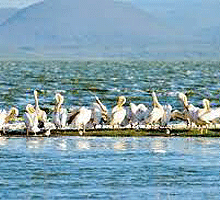
Lake Elementaita Wildlife Sanctuary
Lake Elementaita Wildlife Sanctuary. The sanctuary is a bird's haven. It is An Important Bird Area, a Ramsar site, and a World Heritage Site. (IBA) is a site that provides essential habitat to one or more species of breeding, wintering, or migrating birds. The sanctuary has some hot water springs. It is accessible through two gates namely Pelican Gate along the Nairobi - Nakuru Highway and Maji Moto Gate along Kikopey – Elementaita Road.

Lake Simbi National Sanctuary - Lake Victoria Kendu Bay, Kenya
Lake Simbi National Sanctuary is a small volcanic crater soda lake situated outside Kendu Bay, close to the shore of Lake Victoria and 70 km from Kisumu Town. The sanctuary derives its name from Lake Simbi, a small alkaline crater lake with a radius of about 1km. The sanctuary is a prime site for seeing flamingos and also a seasonal landing place for flamingos during their migration from other places such as Lake Nakuru, Lake Bogoria, Lake Natron, and other Lakes in the Rift Valley. Both Lake Simbi and adjacent Odango sites support a substantial bird population that includes flamingos, little grebes, little egrets, and Egyptian geese, making it a haven for bird watchers. Despite its proximity to Lake Victoria, the small volcanic lake has no known inlet or outlet. This explains why it’s strikingly smelly. Activities at Lake Simbi National Sanctuary include bird watching (major activity in this sanctuary), a sacred bath in the Lake, nature walks, and boat rides. The Best Time to visit are the months of January, February March, April, May, October, and November are the ideal months for flamingo watching. Hotels located close to Kendu Bay town include Cold Springs Hotel, The Golden Rays Resort, Hotel Staridge, Homa Bay Tourist Hotel, ACK Guesthouse Homa Bay, Maria Condos, Caroline’s property, Enaiteru, Venus park, O's Serenity, Cool and Calm Homes, Dahlia Hotel and Accommodation.

Lewa Downs Wildlife conservancy
Lewa Wildlife Conservancy is a 250 km² protected area in Kenya's Meru County, bordering Laikipia and Isiolo counties. Situated on the Laikipia Plateau, it offers a variety of landscapes, including acacia woodland, forests, grasslands, and swamps. Visitors can reach Lewa by road, about an hour's drive from Nairobi, or by air, with flights from Wilson Airport to Lewa Downs Airstrip. The conservancy is home to diverse wildlife, including endangered species like black rhinos and Grevy's zebras, and over 500 bird species. Popular activities include day and night game drives, guided walks, and visits to the anti-poaching tracker dogs. Other experiences include cultural visits to Samburu villages, helicopter rides over Mount Kenya, and camel or horseback safaris. Lewa's climate is warm with moderate humidity, and the best times to visit are from June to September and December to March. Nearby attractions include Borana Conservancy, Meru National Park, and Samburu National Reserve. Lewa also supports community programs, offering visitors a chance to engage with local schools and health outreach initiatives. Accommodation options within Lewa include exclusive lodges such as Elewana Kifaru House, Lewa Safari Camp, and Sirikoi Lodge, each providing a unique safari experience. Profits from tourism directly support conservation and community efforts.

Mara Ripoi Conservancy - Masai Mara Game Reserve
Mara Ripoi Conservancy is a 13,500-acre wildlife conservancy belonging to about 1,600 local Maasai individuals from the community who have leased it out so that the area can be conserved as protected habitat for the teeming wildlife. The Mara Ripoi Conservancy has a large abundance of wildlife, especially the Maasai giraffe, and is an important area for wildebeest and big cats. The conservancy connects to Siana Conservancy and then directly to the Mara Reserve, allowing free movement of wildlife from the Reserve as well as across a wildlife corridor along the Ripole River to Ol Kinyei Conservancy. This has made Mara Ripoi a critical protected habitat connecting important and large wildlife areas and allowing free movement of elephants, lions, cheetahs, herbivores, and many other animals. Mara Ripoi Conservancy is home to only three small safari camps making this an exclusive experience. The camps are set up with a density ratio in mind, with each guest tent protecting 700 acres of wilderness. Apart from the 3 small eco-camps, no other tourist vehicles are allowed into the Conservancy so guests have the thousands of acres in the conservancy to themselves. Located within the Mara-Serengeti ecosystem, Mara Ripoi is renowned for its diverse landscapes and abundance of wildlife, including being excellent lion habitat.
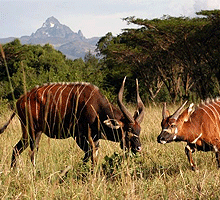
Mount Kenya Wildlife Conservancy - Animal Orphanage
Located within the Mount Kenya Wildlife Conservancy, the Animal Orphanage is a unique facility to give orphaned, injured, neglected, abused, or frightened wild animals a second chance. The Orphanage provides shelter and professional care with the aim of releasing these animals back into the wild where they belong. The Animal Orphanage is open daily from 10:00 am to 5:00 pm, where our experienced guides will give you a tour of the facility as you make new animal friends. The Animal Orphanage solely sustains its operations of the Animal Orphanage by charging an entrance fee and sales from the gift shop. Other activities within the Conservancy include; Horse Riding, bike riding, and Mountain Bongo Tracking. Mount Kenya Wildlife Conservancy (MKWC) is a non-profit trust dedicated to preserving the environment and the wildlife within. The Conservancy is located in Nanyuki, at the foot of the scenic Mount Kenya forest ecosystem, a UN World Heritage Site, and an important and rich biodiverse area. It is home to 28 different animal species, a population of roughly 1,200 different animals. The Conservancy's three main programs include a breeding and rewilding project for the critically endangered Mountain Bongo antelope, an animal orphanage, and a conservation education program.

Mbulia Conservancy/Mbulia Group Ranch (on the eastern boundary of Tsavo East National Park)
Mbulia Conservancy is 48-sq-km and is one of the 28 ranches that form the Taita ranches. The ranch neighbors the Eastern boundary of Tsavo East National park and adjoins the southern side of the Upper Tsavo West segment. The ranch is the most critical dry-season habitat and migratory corridor for wildlife in the Tsavo Conservation Area. In December 2011, following five years of community work by Amara Conservation and local leaders, the community agreed to set aside 11,400 acres of Mbulia Group Ranch as a conservancy. Mbulia conservancy offers scenic landscapes and rolling green hills make for stunning vistas. From palm trees to baobabs, and a large diversity of different landscapes! There is abundant wildlife such as Oryx, elephants lions, leopards, wild dogs, rhinos, hippos, zebras and giraffes.

Namunyak Community Conservancy
Namunyak Community Conservancy is a vast 850,000-acre wilderness surrounding the Mathews Mountain Range in Northern Kenya. As one of Africa’s most successful community conservation models, it offers a pristine landscape where the indigenous Samburu people coexist harmoniously with wildlife. This critical migration corridor supports thousands of elephants, the rare De Brazza’s colobus monkey, and the "Samburu Special Five," making it a biodiversity hotspot. The conservancy hosts three exclusive eco-properties designed for intimacy and sustainability: the flagship Sarara Camp, the private family-style Loimugi House, and the spectacular exclusive-use Reteti House. Access is via a scenic 8–9-hour drive from Nairobi or a 1.5-hour scheduled flight to Kalama or Buffalo Springs airstrips, followed by a road transfer. Namunyak offers deeply immersive experiences, highlighted by the Reteti Elephant Sanctuary (Africa’s first community-owned elephant orphanage) and the ancient, authentic tradition of the "Singing Wells." Guests can explore the lush Mathews Forest on walking safaris, enjoy game drives to spot leopards and wild dogs, or hike to the sacred Mount Ololokwe for breathtaking views of the northern frontier.
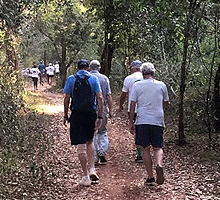
Ngong Forest Sanctuary
The Ngong Road Forest covers an area approximately three and a half times the size of New York City’s Central Park. The forest is divided by the Ngong Road into two main sections, the Miotoni Section to the North West and the Racecourse and Kibera section to the South East. These sections in turn are divided by the Southern Bypass. Located only 6 km from Nairobi’s central business district, the Ngong Forest is a precious resource for Kenya’s capital city. The Forest covers an area of 12 square km and is managed by the Kenya Forest Service and the Ngong Road Forest Association. The Ngong Forest Sanctuary has at least 100 different bird species, attracted by the over 350 species of indigenous and exotic plantations. Birds include the African Harrier Hawk, crows, ducks, owls, sparrows, doves, weavers, vultures, starlings, hoopoes, honeyguides, trogons, Narina trogons, crowned eagles, etc. There are over 35 species of mammals which include Bush Buck, Dik Dik, Duiker, Suni, Leopard, Hyena (spotted), Baboon, Vervet Monkey, Aardvark, Porcupine, Squirrel, and Tree Hyrax. Amphibians such as Toads and frogs, and reptiles such as tortoises, Lizards, and snakes. The forest attracts families, joggers, hikers, mountain bikers, and visitors searching for a slice of peace and quiet.

Ngutuni Wildlife Conservancy
Ngutuni Wildlife Conservancy is a 10,000-acre private sanctuary between Tsavo East and Tsavo West National Parks, surrounded on three sides by Tsavo East. Once home to the infamous man-eating lions of Tsavo, Ngutuni is now a haven for wildlife viewing, especially lions, elephants, giraffes, zebras, buffalo, and over 500 bird species. Unique for allowing night game drives, it offers a rare chance to spot nocturnal species like hyenas and leopards. The conservancy lies just 2.5 hours from Mombasa and is easily accessible via the Mombasa-Nairobi highway or modern railway, with Voi station less than 20 minutes away. Visitors can enjoy activities such as day and night game drives, bush dining, birdwatching, and sundowners with views of the Sagala Hills. Ngutuni Safari Lodge is the only accommodation within the conservancy. Situated near a central waterhole, it offers 48 stone-built rooms with balconies overlooking the savannah. The lodge features a restaurant, bar, lounge, swimming pool, and a viewing deck for wildlife observation. Just 15 km from Voi, the lodge provides a convenient and immersive safari experience that blends comfort with the raw beauty of Kenya’s wilderness.
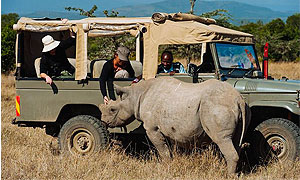
Ol Pejeta Conservancy
Ol Pejeta Conservancy, established in 1988, spans approximately 90,000 acres on the Laikipia Plateau near Nanyuki, Kenya, 217 kilometers north of Nairobi. The conservancy's diverse habitats include open plains, acacia woodland, and riverine areas, supporting a wide range of wildlife. The climate is consistent year-round, with moderate daytime temperatures. The dry season from June to October and December to March is the best time to visit, offering easier travel on dirt roads and fewer tourists outside of high-season months like July, August, and December. Visitors can reach Ol Pejeta by road, with a 3-4 hour drive from Nairobi, or by air, with daily flights to Nanyuki Airstrip, 45 minutes from the conservancy. Activities include game drives, night drives, meeting the last two northern white rhinos, participating in dog and lion tracking, and learning about wildlife-livestock integration. Walking safaris, running in the wild, and visits to the Chimpanzee Sanctuary are also popular. Accommodation options range from luxurious camps like Kicheche Laikipia Camp and Ol Pejeta Bush Camp to budget-friendly options like The Stables. Other notable accommodations include Ol Pejeta Safari Cottages, Pelican House, Porini Rhino Camp, Sanctuary Tambarare Camp, Sweetwaters Serena Camp, The River Camp, Maisha Sweetwaters Camp, Rift Valley Adventures Camp, and the historic Ol Pejeta House.
Reteti Elephant Sanctuary - Namunyak Community Conservancy - Samburu
Reteti Elephant Sanctuary, situated within Northern Kenya’s vast Namunyak Community Conservancy, is Africa’s first community-owned and run elephant orphanage. Nestled at the foot of the Mathews Mountain Range, this groundbreaking initiative represents a new wave of conservation where the indigenous Samburu people are the primary stewards of their wildlife. The sanctuary is dedicated to the rescue, rehabilitation, and eventual rewilding of orphaned and abandoned elephant calves, providing them with a second chance in their natural habitat. Uniquely, Reteti employs Samburu keepers, including the continent's first female elephant keepers, and operates on a "milk economy," sourcing goat milk from local women to feed the orphans, thereby directly empowering the community. Visitors can witness the "thrilling pandemonium" of feeding time from a viewing platform and engage with keepers to understand the deep bonds formed during recovery. Accessible via an 8-hour drive from Nairobi or a scheduled flight to Kalama or Buffalo Springs airstrips, a visit to Reteti is more than a tour; it is an immersion into a circular economy where wildlife protection funds education, healthcare, and sustainable livelihoods. Nearby eco-lodges, such as the exclusive Reteti House, offer the ideal base for this inspiring experience.
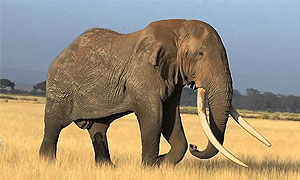
Selenkay conservancy
Selenkay Conservancy is a 15,000-acre Maasai-owned private conservancy situated just 16 km north of Amboseli National Park, sharing the same rich ecosystem. Established on land leased from the local Maasai by Gamewatchers Safaris and Porini Camps, its mission is to protect wildlife habitats, mitigate human-wildlife conflict, and provide alternative livelihoods to local communities through conservation-based tourism. The Conservancy is reachable by road or air. By road, it’s a 230 km drive south from Nairobi, approximately four hours via safari 4x4 vehicles, or a short 16 km private track from Amboseli National Park. By air, flights from Nairobi to Amboseli Airstrip take 35 minutes. Charter planes land at nearby Selenkay Airstrip for a short transfer to the camp. The conservancy serves as a vital dispersal area and migration corridor for elephants, giraffes, zebras, wildebeest, and other species, allowing them to move safely between Amboseli and the surrounding lands. Elephant herds, absent for over 20 years, have returned, and populations of lions, cheetahs, leopards, and rare antelopes such as gerenuks and lesser kudus thrive in the thick bush and open plains. Birdlife is exceptionally diverse, with over 400 species recorded, including colorful bee-eaters, lilac-breasted rollers, starlings, ostriches, and waterbirds in seasonal wetlands. The conservancy’s private, unfenced landscape allows wildlife to behave naturally, and visitors benefit from off-road drives, walking safaris, and expert Maasai trackers guiding every adventure. Porini Amboseli Camp, the sole accommodation within Selenkay, offers a low-impact, intimate safari experience with traditional safari tents, guided game drives, night safaris, and cultural visits.
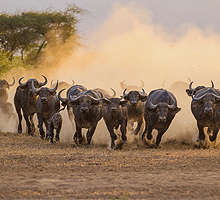
Shompole Conservancy
Shompole Conservancy is a large privately operated conservation area in the south of the Great Rift Valley, Kenya. It is located between Lake Magadi to the north and Lake Natron to the south, two alkaline lakes. The conservancy covers part of the 62,700 hectares (155,000 acres) Shompole group ranch. The Great Rift Valley wall borders the western side while to the east are the Shompole wetlands and further east is Lake Magadi, well known for its flamingoes and stunning colors. South is the Tanzanian border and also Lake Natron also an alkaline lake with flamingoes and stunning reds, pinks, greens, and yellow colors, just like Lake Magadi. This area is owned by the Maasai and they have set aside a conservancy that acts like a grass bank for the dry season for their cattle. However, there is plenty of wildlife in the area and it is well known for its night game drives. Wildlife includes giraffes, buffalo, elephants, and desert antelopes such as gerenuk and oryx. There are over 450 species of birds. The Conservancy has a dry climate, hottest in October and November and most likely to be wet in April and May.
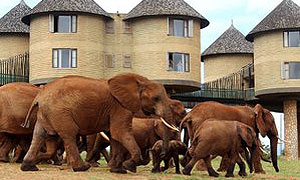
Taita Hills Wildlife Sanctuary
Taita Hills Wildlife Sanctuary, located in Kenya's Taita-Taveta County, is a notable private wildlife reserve established in 1972 by Hilton International. Covering approximately 28,000 acres (113 square kilometers), the sanctuary is adjacent to Tsavo West National Park and the LUMO Community Wildlife Sanctuary. The sanctuary is renowned for its diverse ecosystem, featuring over 50 species of large mammals and more than 390 bird species. Visitors can spot elephants, lions, leopards, cheetahs, zebras, giraffes, buffaloes, and various antelope species. The area's vegetation is primarily savanna woodland and grassland, interspersed with riverine forests, creating a rich habitat for wildlife. Accommodations within the sanctuary include the Salt Lick Safari Lodge, known for its unique stilted rooms and close-up wildlife viewing, and the Taita Hills Safari Resort & Spa, which offers modern amenities and picturesque garden views. Both lodges provide a range of activities, such as game drives, bird watching, guided walks, and cultural tours, ensuring a comprehensive safari experience. Conservation efforts at Taita Hills are robust, with initiatives focusing on biodiversity recovery, wildlife monitoring, and anti-poaching measures. The sanctuary also runs a wildlife education center to promote awareness and conservation education among visitors and the local community.
Taita Wildlife Conservancy
Taita Wildlife Conservancy is a remarkable 96,000-acre sanctuary in Kenya, located in Voi Sub County, Taita Taveta County, approximately 380 kilometers from Nairobi and 110 kilometers from Mombasa. The best time to visit is during the dry season from June to October, which offers optimal wildlife viewing as animals gather around water sources. Birdwatchers may prefer November to April, the migratory bird season, despite peak rains in November and March to April. Home to over 50 large mammal species and 300 bird species, Taita Wildlife Conservancy is a haven for the endangered Grevy’s zebra, African Sandalwood, Cape buffalos, and Elands. Birdlife includes marsh warblers, river warblers, red-backed shrikes, thrush nightingales, common whitethroats, and African eagles, providing breathtaking evening spectacles. Access is possible by road from Nairobi or Mombasa, by air via Moi International Airport or Voi Airstrip, or by SGR train to Voi station. Activities include bush walks, game drives, bird watching, community visits, and hiking up Kizima Hill for historical insights and panoramic views. Accommodation ranges from the eco-friendly Kivuko Eco Camp, offering views of wildlife at a waterhole and Mount Kilimanjaro on clear days, to campsites like Kivuko and Kizima, ideal for those seeking a closer connection with nature.
Booking & Reservations Kenya Wildlife Conservancies Contact
Mobile: + 254-780-242-711
WhatsApp: +254-721-242-711
Reservations: +254 718-179-967
Email: [email protected]
Website: https://africanspicesafaris.com
